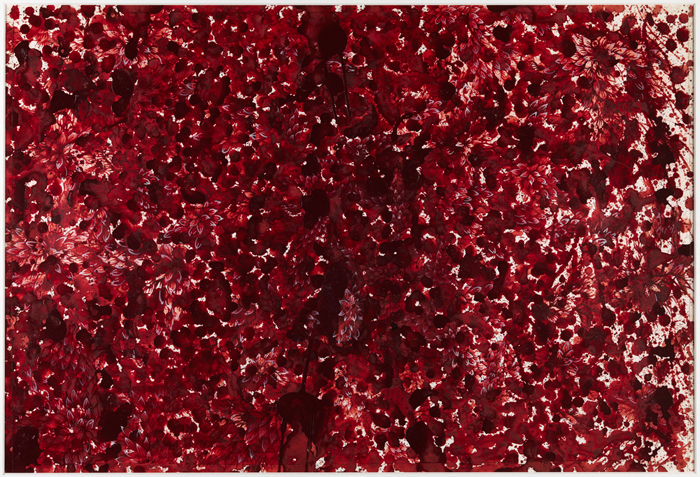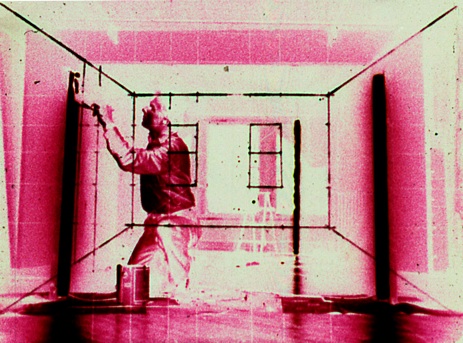
© » KADIST
Noara Quintana
The series Belle Époque of the Tropics by Noara Quintana has as its background the history of the rubber industrialization in North of Brazil. The so-called Amazon Rubber Boom, 1879 to 1912, was an important part of the economic and social history of the country and Amazonian regions of neighboring countries, related to the extraction and commercialization of latex. Centered in the Amazon river basin, the boom resulted in a large expansion of European colonization in the area, causing cultural and social transformations that wreaked havoc upon Indigenous societies and immense environmental damage.

© » KADIST
Tamar Guimarães
Canoas by Tamar Guimarães is a film made for the 2010 São Paulo biennial as an exercise in the projection of national identity. The main subject and setting of the film is Casa das Canoas, the home that architect Oscar Niemeyer built for himself in the early 1950s. Overlooking the bay on the outskirts of Rio de Janeiro, the building has achieved iconic status in Brazil.

© » KADIST
Hao Liang
Eight Views of Xiao and Xiang is a series of landscapes in the Xiaoxiang region in the modern day Hunan Province, China, and was a popular subject of poems, drawings and paintings during the Song Dynasty (960–1279). Liang follows tradition by interpreting the historical subjects by classical Chinese artists including Dong Yuan (934–962 AD), Mu Xi (died in 1281 AD), Wen Weiming (1470–1559 AD). This reinterpretation represents the meeting point of the Xiang River and the Dongting Lake.

© » KADIST
Imran Qureshi
At first glance, This Day by Imran Qureshi appears to be an energetic, gestural painting reminiscent of Action Painting from the mid-20th century. But upon closer inspection, highly detailed floral elements reveal themselves amongst the bold red brushstrokes. The botanical motifs in Qureshi’s work represent life and regeneration while the red paint refers to death and mortality.

© » KADIST
Mohammed Kazem
“Untitled” was filmed in Bodh Gaya, India during a residency in 2011. There, he came across a scene that appealed to his interest in the political and social aspects of modernity. He filmed a policeman who, seemingly, is controlling traffic.

© » KADIST
Gyempo Wangchuk
The various distinct but connected lineages of Himalayan painting remain thriving languages employed by artists from across the region to express their unique perspective in our shared contemporary world. In Bhutan in particular, this language is prevalent and its maintenance is seen through the political prism of preserving Bhutan’s identity in the global world. That being said, o ffering by Gyempo Wangchuk presented an attempt to bring a critical dimension within the traditional Himalayan forms of expression.

© » KADIST
Miguel Angel Ríos
Superb production values and special effects that in the hands of Miguel Angel Rios do not get in the way or distracts from the content and deep essay of this work. The shadow of Modernity represented via a clear cube floats over and through a barren landscape in Latin America. Juxtaposing the corrupt politics of the land, with the artist’s struggles and questioning of the effects and burden of influence of Modernity.

© » KADIST
Nguyen Trinh Thi
The essay film How to Improve the World by Nguyen Trinh Thi takes us into an indigenous village of the Jrai people in the Central Highlands of Vietnam, in Gia Lai province. It begins with sound – perhaps a hammer, or a gong – the lack of image making its identification difficult. A landscape emerges of an open field where a farmer tends his grazing cow herd.

© » KADIST
Leonor Antunes
Discrepancies with Oaxacan Textile II by Leonor Antunes is a hanging sculpture composed of three elements made of brass. This sculptural work was originally produced for the exhibition Discrepancies with Clara Porset (2018) at Museo Tamayo, which featured reassembled objects from early 20th century Cuban designer Clara Porset. Antunes’s work explores Mexican traditions through a contemporary context.

© » KADIST
Gabriel Sierra
Untitled consists of a small wooden sculpture that leans against a wall. Here, a rectangular piece of wood holds a folded article from a vintage design magazine whose Italian text states: “Villa per una persona sola. Arquitectura Pasadena California.” On the flipside of the paper is a feature with different images of paintings and architecture, including a painting by Piet Mondrian.

© » KADIST
Jianwei Wang
In Dilemma: Three Way Fork in the Road , Wang references Peking opera in a re-interpretation of traditional text. The performance begins with two broad-knife-wielding characters circling each other in conventional operatic steps. Oblivious to the presence of these two on stage, additional characters, in a mix of period costume and contemporary dress, enter the stage in increasing droves to consume a various of foods laid out on a table until they collapse and pile on top of each other.

© » KADIST
Li Ran
The four-channel video installation Same Old Crowd departs from the documentation of an unknown city and takes place in an ambiguous temporal and spatial frame. Twelve characters (amateur actors hired by the artist) appear in black-and-white in highly stylized surroundings wearing patterned cloths. The identities or time period of the characters, all deprived of languages, are impossible to determine.
Leonor Antunes
Leonor Antunes’s sculptures consider and reinterpret 20th century design, architecture, and modernist art, focusing in particular on work created by women...
Jianwei Wang
- location: Beijing, China
- year born: 1958
- gender: male
- nationality: Chinese
- home town: Sichuan Province, China
Imran Qureshi
Pakistani artist Imran Qureshi’s practice revives 16th century Mughal miniature painting...
Gyempo Wangchuk
Gyempo Wangchuk is a unique artist in the Bhutanese, and wider Himalayan context because he combines his classical training in traditional Bhutanese painting with contemporary concepts and aesthetics, as well as discreet but potent expressions of dissidence...
Mohammed Kazem
Mohammed Kazem (b...
Li Ran
- location: Beijing, China
- year born: 1986
- gender: male
- nationality: Chinese
- home town: Hubei Province, China
Gabriel Sierra
Colombian artist Gabriel Sierra’s work lies in the intersection between art and design...
Juan Araujo
- year born: 1971
- gender: male
- nationality: Spanish
- home town: Caracas, Venezuela
Nguyen Trinh Thi
Nguyen Trinh Thi is a moving image pioneer, not only within the landscape of contemporary art in Vietnam, but also broader South East Asia...
Noara Quintana
Noara Quintana’s research-based practice focuses on the materiality of everyday objects and their interconnection with sociopolitical and historical processes in the Global South...
Hao Liang
The work of Hao Liang reimagines and explores the sublime of contemporary ecological landscapes...
-
2000-2009
Jianwei Wang
2007In Dilemma: Three Way Fork in the Road , Wang references Peking opera in a re-interpretation of traditional text...
-
2010-2019
Tamar Guimarães
2010Canoas by Tamar Guimarães is a film made for the 2010 São Paulo biennial as an exercise in the projection of national identity...
Miguel Angel Ríos
2012Superb production values and special effects that in the hands of Miguel Angel Rios do not get in the way or distracts from the content and deep essay of this work...
Gyempo Wangchuk
2016The various distinct but connected lineages of Himalayan painting remain thriving languages employed by artists from across the region to express their unique perspective in our shared contemporary world...
Imran Qureshi
2017At first glance, This Day by Imran Qureshi appears to be an energetic, gestural painting reminiscent of Action Painting from the mid-20th century...
Leonor Antunes
2018Discrepancies with Oaxacan Textile II by Leonor Antunes is a hanging sculpture composed of three elements made of brass...
Noara Quintana
2019The series Belle Époque of the Tropics by Noara Quintana has as its background the history of the rubber industrialization in North of Brazil...
-
2020-2029
Nguyen Trinh Thi
2021The essay film How to Improve the World by Nguyen Trinh Thi takes us into an indigenous village of the Jrai people in the Central Highlands of Vietnam, in Gia Lai province...









